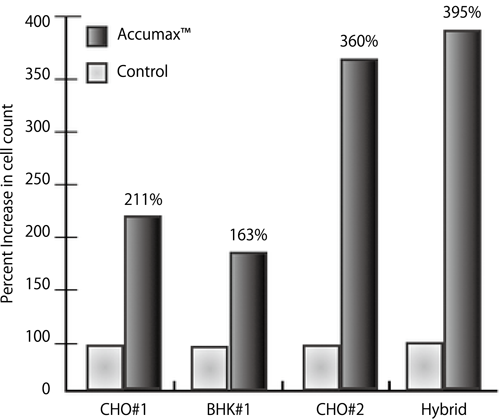Cell Dissociation Reagents (Accumax)
Features
- Dissociates tissue.
- Increases accuracy of manual or automated cell counts.
- Used to dissolve neuronal and prostate spheroids.
- Removes cells from 3-D matrixes.
- Removes cells from hollow fiber cell reactors.
- Extends the sort time of clumpy cell on a sorting flow cytometer.
Cell Lines Tested
Cell Lines Cryopreserved with Accumax
A few cell lines that Accumax has been shown to work on without harm:
- hESCs
- fibroblasts
- keratinocytes
- vascular endothelial cells
- hepatocytes
- vascular smooth muscle cells
- hepatocyte progenitors
- primary chick embryo neuronal cells
- bone marrow stem cells
- adherent CHO cells
- adherent BHK cells
- macrophages
- 293 cells
- L929 cells
- immortalized mouse testicular germ cells
- 3T3
- Vero
- COS
- HeLa
- NT2
- MG63
- M24
- A375 metastatic melanoma
- gliomas U251
- gliomas D54
- HT1080 fibrosarcoma cells
- Sf9 insect cells
Applications
■Increase in Cell Counts

Protocols
Typical Protocol for Cell counting / Dissociation of spheroids by Using Accumax
Thawing Accumax
Thaw Accumax at 4°C overnight or in a cool water bath. Do NOT thaw at 37°C. A thawed bottle of Accumax can be removed from the refrigerator and immediately applied to cells. It does not need to be, and should NOT be pre-warmed to 37°C.
Cell counting
- Place a 0.5 or 1.0 mL volume of clumped cells in a tube.
- Add an equal volume of Accumax to the sample, and incubate for 5-10 minutes at room temperature.
- Count cells using standard procedures.
Dissociation of spheroids
- If the spheroids are attached to the tissue culture flask, the media should be poured off and a quantity of cold Accumax is added to the flask to sufficiently cover the attached layer. A few minutes is required for the spheroids to detach. Proceed to step 3.
- Free floating spheroids should be poured into a centrifuge tube, and precipitated by gentle centrifugation The media should be aspirated from the tube.
- Add cold Accumax into the centrifuge tube. A sufficient volume of Accumax should be added to achieve free-floating spheroids. (e.g. Add 15-20 mL of Accumax into a 50 mL centrifuge tube.) The required Accumax volume depends on the size and quantity of the spheroids.
- Shake the tube gently on a tube rocker and observe the floating spheroids over time, checking every 5 minutes. Shaking should be performed at toom temperature (not 37°C).
- The structure of the spheroids should sart to break down to resemble loose flaps of tissue. At this point, try gently pipetting the flaps up and down several times to further dissociate the spheroids. Repeat this process every few minutes until the spheroids have dissolved.
FAQ
Q: What is the difference between Accutase and Accumax?
A: Accumax contains the same proteolytic and collagenolytic enzymes as Accutase, but is formulated at a concentration that is 3X higher and does not contain phenol red.
Q: The Accutase or Accumax arrived partially thawed. Can I still use it?
A: Yes. As long as the product contains an "ice-cube" or is cool to the touch it can be placed in the refrigerator for later use. It also can be refrozen for long term storage (if frozen within two months of receipt)with white Paper on this.
Q: I did not read the insert thoroughly and thawed it at 37°C. Can I still use it?
A: If it was exposed to 37°C just until complete thawing was achieved without raising its temperature to 37°C, it still can be used. However, it could result in decreased enzyme activity and it may take more time to get full dissociation. If you observe this, consider starting with a new bottle. If a bottle of Accutase or Accumax is kept at 37°C for more than one hour, it will lose its activity.
Q: Do I need to aliquot and refreeze Accutase or Accumax after I defrost a bottle?
A: No. Once thawed, it is stable for at least 2 months in the refrigerator if stored promptly after use.
References
- Goto, K. et al. Simple Derivation of Spinal Motor Neurons from ESCs/iPSCs Using Sendai Virus Vectors. Mol. Ther. Methods Clin. Dev. 4, 115-125 (2017).
- Yamada, S. et al. Chlorpyrifos inhibits neural induction via Mfn1-mediated mitochondrial dysfunction in human induced pluripotent stem cells. Sci. Rep. 7, 40925 (2017).
- 3.Ikuno, T. et al. Correction: Efficient and robust differentiation of endothelial cells from human induced pluripotent stem cells via lineage control with VEGF and cyclic AMP. PLoS One. 12(4), e0176238 (2017).
- 4.Morizane, A. et al. MHC matching improves engraftment of iPSC-derived neurons in non-human primates. Nat Commun. 8(1), 385 (2017).
- 5.Tanaka, G. et al. Dual pharmacological inhibition of glutathione and thioredoxin systems synergizes to kill colorectal carcinoma stem cells. Cancer Med. 5(9), 2544-57 (2016).
Ordering information
(Storage) RT: Room temperature, A: Cool and dark, R: Refrigerator, F: Freeze



